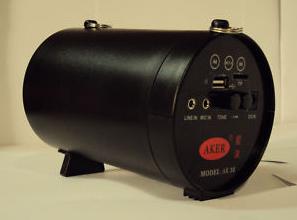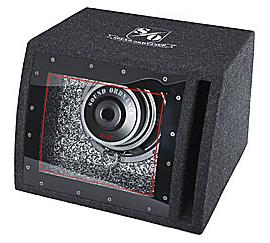A Watt is not a Watt, What?
I’ve just started to work with sound for the first time. Oh, I’ve dabbled a little bit in the record-able birthday card arena, built a couple of embedded amplifiers and a filter (strong word for a capacitor) or two, but I’m pretty clueless when it comes to the sound lingo.
The HeartBeat Dome project requires two speakers, one that runs all the time and the other that spits out heartbeats. My project partner Lex found this perfectly sized (4″ diameter, 8″ length) speaker on eBay to run the all-the-time sound.

The speaker’s specifications say 25 Watt Peak Power Output.
As an electrical person, I took this spec to mean Maximum power output 25 Watts at full volume.
I have no idea what 25 Watts sounds like, but Lex reminded me how loud his high school band was with a 40 Watt amplifier.
Since I am doing some power supply design that encompasses all the speakers, it is necessary to know exactly how much power the speaker consumes.
So I plug the AC to DC converter wall wart into the power strip and from the DC side of the wall wart, I measure 9.5 Volts and something like 250 mA. Which V*A = just under 3 Watts input. Hm. Confusion. Really? You can put 3 Watts in and get 25 watts out? Further research shows there is a battery inside the speaker, so without the AC wall wart using up all the power, the battery can theoretically at optimal condition, put out 2A / 7.5V. Still, this is 15 Watts…not the advertised 25.
So I write to the company and get this back:
Dear Sophi,
The power is described as the peak output power 25 watts. If we just
calculate the power by volts and the current, then it cannot be
25watts. What’s more, our techinican also specified about the power. I
once have told him about this issue, it can be explained as the above.
Have a nice week.
Best regards,
XXX
OK…now I’m annoyed. Is it possible that Electrical Watts are different than Audio Watts?
I’m sure you all know the answer to this. A unit is a definition. So all Watts are Watts.
Electrical Watts are quite easy to calculate, but Audio Watts less so.
I grabbed the following awesome example from Crown Audio.
Example: You are designing a system where the farthest listening position from the loudspeaker is 100 meters, and the desired Sound Pressure Level is 85 dB SPL The loudspeaker chosen for the job has a sensitivity rating of 95 dB. With the minimum recommended amplifier headroom of 3 dB, then you need to choose an amplifier that can supply at least 1,995 watts to the loudspeaker.
Equations used to calculate the data:
dBW = Lreq – Lsens + 20 * Log (D2/Dref) + HR
W = 10 to the power of (dBW / 10)
Where:
Lreq = required SPL at listener
Lsens = loudspeaker sensitivity (1W/1M)
D2 = loudspeaker-to-listener distance
Dref = reference distance
HR = desired amplifier headroom
dBW = ratio of power referenced to 1 watt
W = power required
So moving forward, I have another speaker, a subwoofer-amplifier-powered deal that is about 1.5 cubic feet and rated at 80 Watts. I go through the same routine again, measuring the voltage and current input. I get just about 35 Watts input. The input power is related to how loud my signal is. I ask a friend to record me something at an insanely loud amplitude but I can’t get the input power over 43 Watts.

I’m guessing these specs are a marketing trick by people who are math clueless. And if you really can get more power out of an audio amplifier than you put in, Global Energy Crisis= SOLVED!